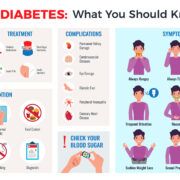
Diabetes mellitus, commonly known simply as diabetes, is a chronic metabolic disorder that affects millions of people globally. It is characterized by high blood sugar levels resulting from insufficient insulin production or the body’s inability to use insulin effectively. Insulin is a hormone produced by the pancreas that regulates blood sugar.
Diabetes mellitus affects all age groups and can lead to severe health complications if not managed properly. Understanding its causes, types, symptoms, and treatments can help manage the condition effectively.
What is Diabetes Mellitus?
Diabetes mellitus is a chronic disease when the body cannot regulate glucose levels properly. Glucose is essential for energy production, but when levels remain elevated, it can damage various organs and systems.
The two primary forms of diabetes are Type 1 and Type 2 diabetes, with Type 2 being far more common. There is also gestational diabetes, which occurs during pregnancy.
Types of Diabetes Mellitus
There are three main types of diabetes:
- Type 1 Diabetes occurs when the body fails to produce insulin, requiring individuals to depend on external insulin sources. It is typically diagnosed in children and young adults.
- Type 2 Diabetes: The most common form of diabetes, where the body either resists the effects of insulin or doesn’t produce enough insulin. It is often linked to lifestyle factors, such as obesity and lack of physical activity.
- Gestational Diabetes: This form of diabetes develops during pregnancy and usually disappears after childbirth, though it increases the risk of developing Type 2 diabetes later in life.
Type 1 Diabetes
Type 1 diabetes is an autoimmune condition in which the body’s immune system mistakenly attacks and destroys the insulin-producing cells in the pancreas, resulting in little or no insulin production. People with Type 1 diabetes must take insulin daily to manage their blood sugar levels.
Key facts about Type 1 diabetes:
- It is usually diagnosed in children and young adults.
- Requires lifelong insulin therapy.
- The exact cause is unknown but is believed to be a combination of genetic and environmental factors.
Type 2 Diabetes
Type 2 diabetes is more common and is closely associated with lifestyle factors such as obesity, inactivity, and poor diet. In this condition, the body either does not produce enough insulin or becomes resistant to the insulin it does produce, leading to high blood sugar levels.
Key facts about Type 2 diabetes:
- It can often be managed with lifestyle changes such as diet and exercise.
- In some cases, medications or insulin therapy may be required.
- Risk factors include obesity, age, family history, and sedentary lifestyle.
Gestational Diabetes
Gestational diabetes is a form of diabetes that occurs during pregnancy. It usually resolves after the baby is born but increases the risk of both the mother and child developing Type 2 diabetes later in life.
Key facts about gestational diabetes:
- It usually develops in the second half of pregnancy.
- It can lead to complications for both the mother and baby if not managed properly.
- Risk factors include obesity, a family history of diabetes, and being over 25 years old during pregnancy.
Causes and Risk Factors of Diabetes
The causes of diabetes vary depending on the type:
- Type 1 Diabetes: Autoimmune destruction of insulin-producing cells.
- Type 2 Diabetes: Insulin resistance, often triggered by obesity, inactivity, and genetic factors.
- Gestational Diabetes: Hormonal changes during pregnancy can impair insulin action.
Risk factors include:
- Family history of diabetes
- Sedentary lifestyle
- Poor diet high in sugar and processed foods
- Obesity, especially excess belly fat
Symptoms of Diabetes
The symptoms of diabetes can be subtle, especially in the early stages. Common symptoms include:
- Feeling extremely thirsty
- Frequent urination, especially at night
- Blurred vision
- Fatigue
- Unintentional weight loss (particularly in Type 1 diabetes)
If left untreated, diabetes can lead to more severe symptoms, including infections, nerve damage, and slow-healing wounds.
Diagnosis of Diabetes
Diabetes is diagnosed through several blood tests that measure blood glucose levels. The most common tests include:
- HbA1c Test: Measures average blood glucose over the past 2 to 3 months. A result of 6.5% or higher indicates diabetes.
- Fasting Plasma Glucose (FPG) Test: This test measures blood sugar after fasting for at least 8 hours. A result of 126 mg/dL (7.0 mmol/L) or higher indicates diabetes.
- Oral Glucose Tolerance Test (OGTT): This test measures blood glucose before and 2 hours after drinking a glucose-containing beverage. A 200 mg/dL (11.1 mmol/L) or higher indicates diabetes.
Complications of Diabetes
Uncontrolled diabetes can lead to severe complications affecting various parts of the body. Some common complications include:
- Cardiovascular disease: Increased risk of heart attacks and strokes.
- Kidney disease: Diabetes can cause kidney failure over time.
- Eye damage: Diabetic retinopathy can lead to blindness.
- Nerve damage: Peripheral neuropathy can cause numbness, pain, and infections, particularly in the feet.
- Foot ulcers and amputations: Due to poor circulation and nerve damage, untreated sores and infections may lead to amputations.
Management and Treatment of Diabetes
Managing diabetes requires a combination of lifestyle changes and, in some cases, medication.
- Type 1 Diabetes: Requires daily insulin injections or an insulin pump.
- Type 2 Diabetes: Can often be managed with diet and exercise. Medications, such as metformin, may be prescribed, and some people may eventually require insulin therapy.
- Gestational Diabetes: Typically managed with a healthy diet and exercise, though some cases may require insulin therapy.
Prevention of Diabetes
Preventing Type 2 diabetes is often possible through lifestyle changes. The following steps can significantly reduce the risk:
- Maintaining a healthy weight: Excess body fat increases insulin resistance, especially around the abdomen.
- Stay active: Aim for at least 30 minutes of moderate exercise, 5 days a week.
- Healthy diet: Focus on whole foods, vegetables, lean proteins, and healthy fats. Limit sugar, saturated fats, and highly processed foods.
- Quit smoking: Smoking increases the risk of cardiovascular disease, which is already higher in people with diabetes.
FAQ on Diabetes
- Can diabetes be cured? No, diabetes is a chronic condition that cannot be cured but can be managed through treatment and lifestyle changes.
- How is diabetes diagnosed? Diabetes is diagnosed using blood tests such as the HbA1c, Fasting Plasma Glucose test, or an Oral Glucose Tolerance Test.
- What are the early signs of diabetes? Increased thirst, frequent urination, fatigue, and blurred vision are common early signs.
- Can diabetes be prevented? Type 1 diabetes cannot be prevented, but Type 2 diabetes can often be delayed or prevented through healthy lifestyle changes.
- Is diabetes hereditary? There is a genetic component to both Type 1 and Type 2 diabetes, but lifestyle factors play a significant role in the development of Type 2.
- How does diabetes affect pregnancy? Gestational diabetes can affect pregnancy by increasing the risk of complications such as high birth weight, preterm birth, and the mother’s risk of developing Type 2 diabetes later in life.






